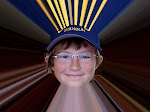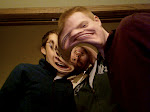Thursday, November 29, 2007
Coming to scale with educational technology
The issue of scaling up is so pertinent to the individual teachers enrolled in this course as we wander through the joys, challenges, and complications of educational technologies. The goal of the Microsoft funded program (in the first reading) is to support research specific and effective applications of technology in classrooms and analyze why they work and more importantly how can the particular activity be applied ( or ramped up) to widespread implementation in classrooms beyond a specific charter school or classroom.
This semester has been a wonderful intellectual enterprise. I have consistently made powerful connections betwixt my History of Science course (Technology and American Culture) and this Education course. Of the many themes --historical and technological--I've explored this semester one in particular resonated with our readings this week. Throughout American history innovations and new technologies initially are integrated into society with little public or government resistance or discussion. Henry Ford's Model T, Bell's telephone, the steam engine, even the development of the atomic bomb initially were seen as positive examples of the American spirit of progress (both economically or militarily) and scientific advancement. As the technologies are enhanced, enlarged or made more widespread, growing concern as to their long term impact or consequences is articulated. Clearly this theme is evident as linked to technology and education.
The most fascinating part of 21 st century information technology as it relates to classroom applications is the rapid pace of development and diffusion. The pace of technological innovations has been so rapid it has left the public discussion and conversation so far beyond it has almost has become moot. The Brave New World is here whether we like it or not!
My final project is on Media Literacy in this Brave New World. Even though 1997 seems like a technological eon ago, educators, consumers, and citizens must continue to engage in courageous conversations about the role of technology in the lives of our students. I have a feeling that the Brave New World of 2007 is going to look awfully blase to the Brave New World of 2027!
Thursday, November 15, 2007
Overdosed and frustrated
Fitz's Second Life
I would invite all of my readers to check out my website at
http://sffitzgerald.googlepages.com/
On the technology page of the website you'll find evidence of my baby steps with several technology tools from powerpoint to moviemaker. Rock on.
Thursday, November 8, 2007
Media Literacy & multi -tasking
Of the eleven core competencies discussed in Jenkins report, one jumped out at me-- it was multi-tasking. Jenkins described schools as having taught students to be farmers ( one step following another) rather than hunters (adapting to changing conditions, thinking quickly, responding efficiently). I think students need to be able to be hunters and farmers. More importantly, I think multitasking is over-hyped as a skill. There are times and activities that lend themselves to multi-tasking (washing dishes while making almond poppyseed muffins) and others do not (driving and talking on a cell phone). My students spend hours longer on homework cause they feel compelled to text message, download and listen to music, and attempt to read a densely written history essay.
Thursday, November 1, 2007
From Freeware to Free Expression
Jay's comments connect ever so fluidly with the philosophy of Constructivist teaching and learning, a common theme throughout this course. It seems that the idea of students expressing themselves is not a "new" idea (see the 1960's Free Speech Movement). What can be considered new as far as student expression in the Digital Information Age is shown in the proliferation of social networking sites. Students are creating their MyFaceSpacebook (my agglomeration which makes my adolescent nieces crazy!) pages for others to interact with and respond to. The challenge to teachers as Jay (alludes to) is to have students as excited about creating and sharing their American history project as they would be in modifying their own MySpace profiles. On some levels education needs to be revamped from one that reflects its origins in the Industrial- Mass-Produced -Standardized -Society. When I reflect on the topics we've read and discussed in class, it seems that education needs to be revamped to reflect the Digital- Information -Collaboration-Creative society that our students will work and live in! The paradigm shift that that will entail makes my head hurt!
I often wish I could time travel and listen in on conversations of educators in the early 20th century as new technologies like electricity, radio, automobiles, and telephones massively reshaped society and what it meant to be educated or successful.
The Henry Jenkins report Confronting the Challenges of Participatory Culture: Media Education for the 21st Century was hard to disagree with. I found several points particularly compelling. Jenkins called for
a. a shift in the focus of the conversation about the digital divide from questions of technological access to those of opportunities to participate AND to develop cultural competencies and social skills needed for full involvement.
b. adult acknowledgement of the creation of new participatory cultures and adolescents' engagement in them.
c. a systemic approach to media education.
What really struck me was how media competency and skills create a new "hidden curriculum" which can prove to be a barrier for student success depending on their access to technology whether at school or at home. While technology integration has been a significant motivating force in my school district, the really, really, really big emphasis has been targeted at the achievement gap as it impacts students of color, non-native speakers, and immigrants. Seems to me that these two driving forces (technology integration and diversity training) could unify around this shared issue.
Thursday, October 25, 2007
Web 2.0 - ichats-and other ponderables
He spent a considerable amount of time on social networking and the profusion of them on the Web. An interesting tangential article would discuss the popularity of these networks and the stratification of use by age, gender, and socio-economic status.
I am struck by the tempo of the technological change impacting the Web. The potential for astounding change and transformation is infinite. At the same time this potential for change is tempered by the dark side of possible societal and certainly educational consequences. It seems that educators and parents and kids should be having a conversation about how technology will impact student learning, how they process information, how they create meaning from that information, and how they critically assess information. Meanwhile the beat goes on and technology whether software or hardware continues to alter our society and schools on micro and macro levels. Sometimes I want to say slow down! I need a moment to catch up, reflect and engage with this new learning.
Thursday, October 11, 2007
Is it really teaching if the students are 'aloud'?
I was struck by the fictional principal feeling more secure and comfortable observing the teacher who had given the same lecture on the same day for nine consecutive years. I think this is the challenge of Constructivist Teaching and Learning. All educators' teaching methodologies reflect their own student-learning experiences which in turn are based on the styles of the teachers they had. So if a teacher had very traditional-quiet classroom experiences that will indeed be how their classroom will be conducted. On the other hand teachers who were able (as students) to be actively engaged in role playing, simulations or student created panel discussions (for a few examples) will in turn develop activities doing the same for their own students.
I think that teachers who are unable to let go of being the knowledge-boss AKA the font of most important stuff--will struggle with integrating technology into their classroom for several reasons. Once students are no longer locked into their desks or focused exclusively on the "front" of the room, they can go almost anywhere intellectually speaking. When students are allowed to process information with classmates and respond with a collaborative version of a reflection paper, a traditional teacher may feel unsure as to the ultimate destination of the discussion because they are unable to anticipate the myriad of questions or situations that may arise from the student group reflection! A teacher who has always managed a quiet very carefully structured classroom may develop small rashes or experience shortness of breath at this point!
I think that the Sprague & Dede article is effective in contrasting the two teacher styles and I purposefully did not highlight it as I want to make copies to share it with some colleagues for their own reflection and feedback. Then again I could pdf it and save the copies (!!).
Wednesday, October 3, 2007
Chinese for Challenge?
I've spent a bit of time "window-blogging"-- which is far less expensive and time consuming than mall crawling. I'm impressed and enthused with the quality of the edu-blogs that I've sampled and excited to delve further into the on-line activities and student examples that ed-bloggers have posted. Blogging has far more potential for teaching and learning on the secondary level than I initially gave it credit in my previous post. I'm resolutely re-evaluating my perspectives on ed-tech. change as they have been so shaped by my own educational journey that prior to 2006 was sans any hint of technology innovation or incorporation. While I've considered myself to be a creative, innovator in the chalkboard classroom, I'm realizing that I must sample other educators strategies to better understand how a 'nology could be incorporated into my history classroom or how it could broaden my teaching repertoire at the same time broadening participation venues for my students. Much less permitting my students to access experiences and perspectives previously unknown and untapped in my chalkboard classroom.
The more I explore and sample the blogging classrooms the more my Baby Boomer Brain can open itself to
taking "teaching techno-risks" and create relevant, compelling, and meaningful learning opportunities for my students!
The Chinese Challenge in the ed-tech revolution comes in the form of the sheer scope of the material and potential. My middle school niece working on a school project will suddenly have a list of published sources found at the local library jump from a decent 12-15 to hundreds maybe thousands of possible sources available on-line. This is where the crucial element of tech. literacy appears as a required learning standard for 21st century learners. Students must be savvy consumers of information as well as being able to critically evaluate information available via the W3.
The other Chinese Challenge involves the finite and unchanging 24 hour day. While educational technology does save time for teachers and students it can also be the equivalent of the La Brea Tar Pits in that a simple search can lead to multiple tangential forks in the cyber-way. Perhaps one of the National Educational Technology Standards needs to include recommending some sort of cyber chip implanted in any search engine that alerts the searcher to the number of minutes, sites, and links visited in their search so that a student or educator working under time constraints can better monitor their effectiveness and efficiency... Then again there probably is such a thing and this tech-novice is simply unaware of such! :-)
Wednesday, September 19, 2007
From blogs to semantic networking
I think I'm more intrigued with educational potential of semantic networking than with blogs. I've become slightly familiar with the work of the National Urban Alliance and a significant teaching tool that they really emphasize: concept maps. The Inspiration software is fun to work with; I wonder if there is a free-ware equivalent somewhere.
I'm impressed with the constructivist direction and design of this class. Seems to me that if I enjoy the flexibility and power of creating my own knowledge, my students will as well. Yet another moment in my U experience that makes me take pause and reflect on what my classroom will look like and sound like when I return to the classroom as well as how my role as teacher will be reconfigured. Now to put words in to action!!
Friday, September 7, 2007
The quandry
I am definitely a visual learner in that I need to see models in order to better understand the how, why, and what of techno-tasks.
I'm also struggling with what I perceive to be my own inefficiencies as far as the amount of time I spent diddling around with things. I often wonder if there are easier ways to do things and I'm too old school or inexperienced to realize and take advantage of. Hmmm.
iToons
London 2005
Enroute to the Tower of London



